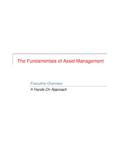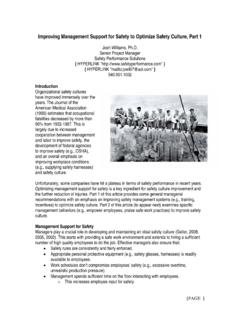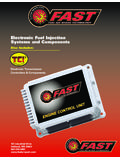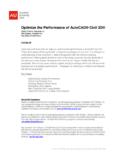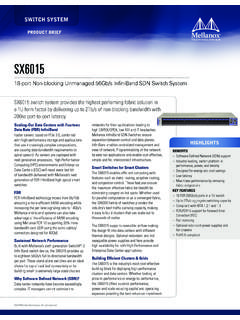Transcription of Value chain management for commodities: a case …
1 OR SpectrumDOI ARTICLEV alue chain management for commodities : a case studyfrom the chemical industryM. Kannegiesser G nther P. van Beek M. Grunow C. Habla Springer-Verlag 2008 AbstractWe present a planning model for chemical commodities related to anindustry case. commodities are standard chemicals characterized by sales and supplyvolatility in volume and Value . Increasing and volatile prices of crude oil-dependentraw materials require coordination of sales and supply decisions by volume and valuethroughout the Value chain to ensure profitability. Contract and spot demand differen-tiation with volatile and uncertain spot prices, spot sales quantity flexibility, spot salesprice quantity functions and variable raw material consumption rates in productionare problem specifics to be considered. Existing chemical industry planning modelsare limited to production and distribution decisions to minimize costs or models focus on uncertainty in demand quantities not in prices.
2 Wedevelop an integrated model to optimize profit by coordinating sales quantity, priceM. Kannegiesser G nther (B)Department of Production management , Technical University of Berlin,Wilmersdorfer Str. 148, 10585 Berlin, Germanye-mail: van BeekManagement Studies Group and Operations Research and Logistics Group,Wageningen University, Hollandseweg 1, 6706 KN Wageningen, The Netherlandse-mail: GrunowDepartment of Manufacturing Engineering and management , Technical University of Denmark,Building 425, 2800 Kgs. Lyngby, Denmarke-mail: HablaDepartment of Enterprise-Wide Software Systems, The Fern Universit t in Hagen,Universit tsstr. 1, 58097 Hagen, Germanye-mail: Kannegiesser et supply decisions throughout the Value chain . A two-phase optimization approachsupports robust planning ensuring minimum profitability even in case of worst-casespot sales price scenarios.
3 Model evaluations with industry case data demonstrate theimpact of elasticities, variable raw material consumption rates and price uncertaintieson planned profit and chain management Sales and supply network planning Demanduncertainty commodities Chemical industry1 IntroductionThe chemical industry is one of the key global industries with product sales ofe1,776 billion globally in 2004 (CEFIC 2005). In this article, we focus on the segmentof chemical commodities . commodities are mass products produced and sold in highvolumes with standardized quality and few variants. Price is the key buying criterionfor customers. Examples are standard polymers, certain types of intermediate productsor basic chemicals. Sales prices for theses commodities are volatile and can changeregularly, , weekly or monthly based on negotiations between the company and for raw materials can also change regularly.
4 Specifically, many key rawmaterials in the chemical industry showed a severe rise in prices due to the increaseof the crude oil price over the last years. Raw price volatility and increases have to beconsidered in sales and supply planning of commodity products to ensure profitabilityof the business. Therefore, the focus on demand and supplyvolumeplanning alone isnot sufficient since a feasible volume plan might not be profitable for the company dueto the volatility of supply costs and sales prices. The monthly planning process needsto support integrated decisions onvolumeandvalues, specifically on sales quantitiesand prices considering available supply volumes and raw material costs. In this paper,an integrated planning model related to a real-life case from the European chemicalindustry is our investigation, we consider a simplified intra-organizationalvalue chain net-workof a company producing chemical commodities .
5 The industry context of thiscase is a company operating a complex, multi-stage Value chain network producingpolymers that also require several intermediate products as raw material. The companyis operating at several production sites and is serving different sales locations. Thebusiness is a commodity business where raw materials and finished products are char-acterized by market price and volume volatility. Annual production volumes exceed 1 Mio. tons. In this study we focus on the monthly sales and operations planning processfor the entire Value chain network for a planning horizon of 6 12 a section of the network. The company has grouped multiple cus-tomers in regional or industry-specific sales locations. Two production resources arelocated in one production location, from where sales locations are served. One market-facing multi-purpose resource produces multiple finished commodity products.
6 Thesecond single-purpose resource produces the intermediate product for the multi-purpose resource in continuous production mode. The intermediate product produced123 Value chain management for commoditiesProduction location 1 Procurement location 1R1R2continuousmulti-purposeProductionSa les location 1 Sales location 1 Sales location 9 Sales location 9 ProcurementSalesSales location 2 Sales location 2raw production locationLl = procurement & sales locationLegend:= resourceRr = material flowTt periods: monthly planning bucket= productPp Fig. 1 Section of the considered Value chain networkon resource R1 requires a raw material product procured from an external planning problem at hand shows a number of characteristics that are typical ofthe chemical industry. Spot and contract business differentiation is an important issue in the chemicalindustry specifically in commodity business.
7 Price and volume volatility for chemical commodities in sales and procurement ismore significant than in other industries, , in discrete parts manufacturing. The entire production system is organized as a multi-stage network with multi-purpose and continuously operated production resources. Material flows are predominantly divergent with intermediates used in multiplesubsequent products. Raw material consumption rates in production are variable depending on the degreeof capacity characteristics can be found, for example, in basic chemicals and/or polymerproduction, while fine chemical and pharmaceutical production can be seen as a spe-cialty type of business relying on smaller quantities and complex batch productionmode. The simplified network as shown in on the interaction betweenprocurement, production and sales.
8 The problem at hand is an excerpt from the globalvalue chain planning problem of a polymer producing company. In our investigationwe focus on the interaction between key business functions in the global Value chaincontext. The model developed represents a prototype which is used by the plannersto better understand volume and Value dynamics from sales to procurement and theirimpact on profit in a Value chain network. In a later stage, the company intends tointroduce the Supply Network Planning module of an advanced planning software123M. Kannegiesser et for operative planning ( 2006). To reduce the complexity ofthe prototype model, several standard features such as inventory records and transpor-tation are excluded mainly because they do not have a high profit impact comparedto sales and procurement issues. Exchange rates and risk hedging inventories are alsoexcluded here though they do represent further important issues in the investigatedglobal Value chain network which will be included in the final implementation of thevalue chain planning , supply network planning models focus on the flow of goods in thenetwork while assuming sales and procurement prices as being fixed.
9 Revenue man-agement, however, represents a topic which has recently gained considerable interestboth in practice and in academia. For an application in the iron and steel industryand a discussion of dynamic pricing in the US automotive industry, et al.(2007) andBiller et al.(2005), respectively. Key issues of revenue management aredynamic pricing strategies as well as accept and reject decisions to make more effec-tive use of resources. Booking and pricing systems of airlines, hotels, car rentals,telecommunication systems and cargo transportation are just a few popular examplesof revenue management , et al.(2007),Bartodziej et al.(2007),Lee et al.(2007),Defregger and Kuhn(2007),Reiner and Natter(2007). These papers focuson revenue maximization based on pricing and decisions to influence the demand forservices such as airline seats, rental car capacity or hotel rooms which are in limitedsupply.
10 Active sales and pricing decisions investigated in revenue management areprincipally relevant for the industrial planning problem considered in our paper. How-ever, in contrast to service industries we deal with physical products and the complexdecision-making process in a global chemical Value paper aims at integrating ideas of revenue management into supply networkplanning to optimize profit throughout the entire intra-organizational Value chain net-work. We choose Value chain management as an overall term for the integration ofdemand-oriented management concepts such as revenue management as well as sup-ply-oriented logistics management concepts which primarily focus on material , our modeling approach reflects the following key issues: For chemical commodities as well as for many other industrial products ( , fer-tilizers or animal feed products),contractandspot demandcan be sales prices and quantities are fixed for contract demand, spot market salescan be highly variable with regard to both price and quantity.

